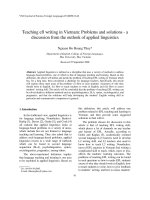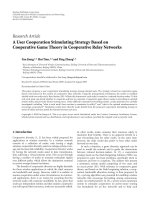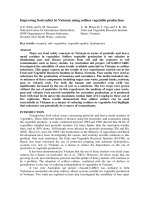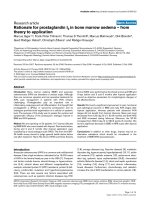Bitcoin regulation in Vietnam - Using cooperative game theory to analyse the cost sharing of Bitcoin
Bạn đang xem bản rút gọn của tài liệu. Xem và tải ngay bản đầy đủ của tài liệu tại đây (2.02 MB, 58 trang )
VIETNAM NATIONAL UNIVERSITY, HANOI
VIETNAM JAPAN UNIVERSITY
VU HOANG DUNG
BITCOIN REGULATION IN VIETNAM –
USING COOPERATIVE GAME THEORY
TO ANALYSE THE COST SHARING OF
BITCOIN
MASTER THESIS
Hanoi, 2019
VIETNAM NATIONAL UNIVERSITY, HANOI
VIETNAM JAPAN UNIVERSITY
VU HOANG DUNG
BITCOIN REGULATION IN VIETNAM –
USING COOPERATIVE GAME THEORY
TO ANALYSE THE COST SHARING OF
BITCOIN
MASTER’S PROGRAM: PUBLIC POLICY
CODE: Pilot
SUPERVISORS:
DR. VU HOANG LINH
ASSOC.PROF. MASAKAZU FUKUZUMI
Hà Nội, 2019
(Chữ thường, đứng, đậm, cỡ chữ 14, font chữ Times New Roman)
ACKNOWLEDGEMENT
Firstly, I would like to express appreciation to Prof. Masakazu Fukuzumi for his
enthusiastic assistance and supports for of my thesis. His lesson inspired me to study
in this new field – game theory, and his explanation has made the work more
interesting. I also want to express the special thanks to Dr. Vu Hoang Linh for his
advice and recommendation. His support helped me find the appropriate topic and
continue with initial research plan.
Secondly, I would like to show appreciation University of Tsukuba and Vietnam
Japan University for giving me a chance to participate the master course in Vietnam
and Japan.
Besides, I greatly appreciate with the continuous support of Office of Global
Initiatives, University of Tsukuba in my 3-month internship.
Finally, I would like to express gratitude to my family, my friends and my teachers
for encouraging me in all the progresses of this thesis.
i
CONTENTS
ACKNOWLEDGEMENT ........................................................................................ i
CONTENTS .............................................................................................................. ii
ABBREVIATIONS ................................................................................................. iii
LIST OF TABLES ....................................................................................................v
LIST OF FIGURES ................................................................................................ vi
ABSTRACT ............................................................................................................ vii
CHAPTER 1: INTRODUCTION ............................................................................1
1.1.
Research background and problem statement ...............................................1
1.2.
Research rationale..........................................................................................2
1.3.
Research questions ........................................................................................2
1.4.
Research methodology and design ................................................................2
1.5.
Research limitation.........................................................................................3
CHAPTER 2: LITERATURE REVIEW ................................................................4
2.1. The characteristics of Bitcoin ...........................................................................4
2.1.1. Bitcoin value ...........................................................................................4
2.1.2. Volatility of Bitcoin price .......................................................................5
2.1.3. Bitcoin community .................................................................................6
2.1.4. Bitcoin Mining ........................................................................................6
2.1.5. Exchange market.....................................................................................7
2.2. Bitcoin regulation in the world .........................................................................7
2.3. Bitcoin regulation in Vietnam ........................................................................11
2.4. Cooperative game theory and cost allocation .................................................14
CHAPTER 3: RESEARCH METHODOLOGY .................................................20
3.1. Research method .............................................................................................20
3.2. Bitcoin cost sharing model ..............................................................................20
3.3. Cost structure in sharing model ......................................................................21
3.4. Cost and utility………………………………………………………………....…24
CHAPTER 4: FINDINGS AND ANALYSIS .......................................................26
ii
4.1. The result of solutions .................................................................................26
4.1.1. The proportional cost allocation method ..................................................26
4.1.2. The core and Nucleolus method ...............................................................27
4.1.3. The Shapley value method .......................................................................31
4.2.
Discussion ....................................................................................................36
CHAPTER 5: POLICY IMPLICATION AND CONCLUSION .......................39
5.1. Policy implication ...........................................................................................39
5.2. Conclusion ......................................................................................................42
5.3. Future research ................................................................................................44
APPENDIX ..............................................................................................................45
REFERENCE……………………………………………………………………..47
iii
ABBREVIATIONS
SBV
State bank of Vietnam
BTC
Bitcoin
ICO
An initial coin offering
iv
LIST OF TABLES
Table 2.1: The status of crypto asset regulations in the world ..................................10
Table 3.1: Cost and utility of players in High price period.......................................23
Table 3.2: Cost of coalitions in High price period ....................................................24
Table 3.3: Cost and utility and player in Low price period ......................................24
Table 3.4: Cost of coalition in Low price period ......................................................25
Table 4.1: Equal proportion cost between players (yi) .............................................26
Table 4.2: Conditional cost of players ......................................................................29
Table 4.3: Terms the amount of x1, x2 and x3 ...........................................................30
Table 4.4: The value of xi solved by Nucleolus method with parameters ................30
Table 4.5: The amount of xi (thousand dollars) for each player ...............................30
Table 4.6: Corresponding cost allocation (thousand dollars) between players based
on Nucleolus method (yi) ..........................................................................................30
Table 4.7: The amount of xi based on Shapley value method in High price period .31
Table 4.8: The amount of xi based on Shapley value method in Low price period ..32
Table 4.9: Cost allocation (thousand dollars) between player based on Shapley
value method (yi) .......................................................................................................33
Table 4.10: Result of solutions in High price period ................................................34
Table 4.11: Results of solutions in Low price period ...............................................35
Table 4.12: Percentage of utility received by each player based on solutions
concepts in High price period ...................................................................................36
Table 4.13: Percentage of utility received by each player based on solutions
concepts in Low price period ....................................................................................36
v
LIST OF FIGURES
Figure 2.1: The price of Bitcoin from April 2018 to April 2019 ................................5
Figure 2.2: Regulatory status of Bitcoins Worldwide in 2018 ...................................8
Figure 2.3: Coalition forms of players ......................................................................16
Figure 2.4: The core of coalitional game ..................................................................17
Figure 3.1: The process of research method .............................................................20
Figure 3.2: Bitcoin cost sharing model .....................................................................22
Figure 4.1: The core – Shapley value – Nucleolus in high price and low price period
...................................................................................................................................33
Figure 4.2: Comparison between cooperative game methods and non-cooperation
situation. (High price period) ....................................................................................34
Figure 4.3: Comparison between cooperative game methods and non-cooperation
situation. (Low price period) .....................................................................................35
Figure 5.1: Bitcoin future ..........................................................................................43
vi
ABSTRACT
In 2017, The State Bank of Vietnam has stated that Bitcoin and other digital
currencies are not a legal method of payment. However, Bitcoin also can be
considered as a commodity, asset or investment channel. At present, while the
number of Bitcoin investors and exchange market is increasing rapidly, there is no
regulation in Vietnam to regulate the issue of this digital currency.
In order to harmonize the interest of stakeholders, this paper suggests the Bitcoin cost
sharing model with cooperative game theory approach to elaborate the incentive why
Bitcoin users should cooperate and form coalitions. From that, it can help citizen
increase the awareness and influence of Bitcoin in new financial environment.
Finally, the findings of this study also intended to assist lawmakers, regulators and
investigators in regulatory process. The study also focuses on educating targeted
readers with the deficiencies in current policies, regulations, and legislation as well
as making recommendations for future updates in the regulation of digital currencies.
Keyword: Bitcoin, Bitcoin regulation, Bitcoin price, Cooperative game theory.
vii
CHAPTER 1: INTRODUCTION
1.1.
Research background and problem statement
Bitcoin is a digital currency introduced in 2008 by a person called “Satoshi
Nakamoto”. It’s an open network which allows online payment to be sent directly
without a third party, transactions follow a public ledger called blockchain
(Nakamoto, 2008). Nowadays, Bitcoin becomes the most widely used and accepted
the digital currency. Moreover, Bitcoin is considered as the financial products
associated with technology but outside of the scope of this research. This thesis only
deals with Bitcoin at economic approach.
Bitcoin users in Vietnam included three main players: investors, Bitcoin miners and
businesses that accept exchange in Bitcoins have grown rapidly, from 30,000 users
in 2016 to 60,000 in 2017 and about 300,000 users in 2018. In this context, currently,
Bitcoin miners, users and businesses cooperate together to build a sustainable
community. However, in some cases of conflict of interest, many users have lost
money and caused adverse impacts on Bitcoin and social awareness of Bitcoin.
In this situation, regulatory authorities have cautioned about the risks related to
Bitcoin, as well as the risk of using virtual currency for criminal activity because
virtual currency is anonymous, decentralized, and not subject to management of any
organization. Investment activities, buying and selling virtual money, mobilizing
capital through issuing virtual money (ICO), especially using virtual money by multilevel marketing is more and more complicated, threatening to affect financial markets,
and can cause huge risks for participating organizations and individuals.
It is difficult for investors to recover money because the regulation on Bitcoin has not
yet been released. When Bitcoin users cooperate together, they must protect their
assets and take risks by themselves. So Vietnam government need to legitimize
Bitcoin in the current Vietnamese context. Besides, policies that directly affect
stakeholders will also reduce frauds and have a better understanding of Bitcoin. These
1
policies not only will benefit and protect Bitcoin stakeholders but also help to
promote innovation technology in Vietnam.
1.2.
Research rationale and research objectives
The rationale behind this topic is to consider legalization of Bitcoin which can be
used for effective regulation of Bitcoin community; apply Game theory model to
calculate reasonable cost in case of price fluctuation. The findings suggest that if we
manage Bitcoin’s system to reduce its cost practices, the rate of loss of the users and
the amount of money in exchange market could be in the acceptable range.
With the background and problem statement mentioned above, this study has aimed
to clarify characteristics and mechanisms of Bitcoin market; and suggest solutions
and policies to incentivize individuals’ contribution and maximize benefits to the
society in Vietnam.
1.3.
Research questions
Based on research problem, the main research question is:
How can Bitcoin be regulated while harmonizing the interests of stakeholders by
applying Bitcoin cost sharing model in Vietnam?
Moreover, some other sub-questions also can be answered in this study:
What is the Bitcoin’s characteristics and how is Bitcoin obtained?
How about legal and regulatory issues of Bitcoin in Vietnam and in the world?
How the Bitcoin cost allocation can be solved using cooperative game theory
and which solutions can be used to get consensus between stakeholders?
Which policies should recommend to manage Bitcoin community in Vietnam?
1.4.
Research methodology and design
In order to clarify problem, this research employed both qualitative research and
cooperative game theory. This thesis firstly provides a conceptual framework of
Bitcoin in Vietnam and around the world. From this analysis, it is possible to examine
the Bitcoin’s characteristics, Bitcoin’s value and suggest the solutions for Bitcoin’s
2
stakeholders. For these purposes, original models which can describe the interaction
between Bitcoin stakeholders and the cost sharing of Bitcoin is developed. With
qualitative instrument, the secondary data is gathered from policies, documents of the
government, company, news and media video.
Quantitative method will enable results of game theory model, discussion and
comparative analysis. The data of Bitcoin price will be collected from official
exchange market, price of mining Bitcoin in Vietnam according to the analytical
publication Elite Fixtures. The costs and utility in the coalitions are stated, after that
the solutions concepts also calculated and analyzed in each situation.
This research is organized into five main chapters. After the introduction, the study
will establish the theoretical framework in which, we provide a literature review and
define important concepts. After which, the thesis will discuss the methodological
approach for the research and explain the cooperative game theory concepts and
solution methods. In chapter four, the results will be calculated in two main periods
and compared to non-cooperative situation. Lastly, policy recommendations will be
suggested based on situation and findings of this research.
1.5. Research limitation
The main limitation is a simple case study, which works purely in the information.
Also, this study cannot to conduct a full empirical analysis. Moreover, this research
also need to analyze the ability to leave the grand coalition of players in the different
situation.
3
CHAPTER 2: LITERATURE REVIEW
The aim of this literature review is to clarify the understanding and appreciation for
the current study. In this chapter, the papers relating to Bitcoin characteristic, Bitcoin
value, cooperative game theory and Bitcoin regulation will be reviewed. After this
progress, the research model will be established and the policy implication could be
found.
2.1. The characteristics of Bitcoin
Bitcoin is new phenomenon, so that many papers explained the Bitcoin characteristics.
Bitcoin is the first decentralized cryptocurrency, its transaction cannot be forged and
the amount of Bitcoin is limited (Nakamoto, 2008). This first document published by
Satoshi Nakamoto describe how the Bitcoin network works.
Bitcoin have many advantages (Mirzayi, 2017). It eliminates transaction costs, is
safer than cash, harder to fake than fiat currency. The potential of Bitcoin outweighs
the threats (Alcorn, Eagke, & Ethan, 2014), however Bitcoin users also need to know
more detailed about the risks that can happen. It is not accidental that many financial
experts oppose Bitcoin, many countries banned Bitcoin, some countries accept
Bitcoin like Japan and Canada but are extremely cautious. The use of Bitcoin is a
medium for illegal activities to transmit proceeds locally or globally (Bryans, 2014).
The difficult of definition Bitcoin’s value make many users lose money when they
speculate Bitcoin or invest to scam projects. Therefore, regulators and investigators
struggled with Bitcoin and the problems associated with this new form of electronic
value transfer system (Ajello, 2015).
Bitcoin value
Bitcoin is an emerging technology based on complex technology. In addition,
Bitcoins are not regulated by a centralized agency till date, make them less reliable
and it is difficult to evaluate Bitcoin value. To invest in Bitcoin, users must believe
in the Bitcoin security, trust any organizations involved, such as wallet services or
4
exchange. Bitcoin is considered as a speculation (Yermack, 2013) and Bitcoin value
has the relationship with the number of search queries for its information on Google
or Wikipedia (Kristoufek, 2015). So, the value of Bitcoin will increase when people
pay more attention to Bitcoin and it is important condition to develop Bitcoin
community.
Volatility of Bitcoin price
Bitcoin price fluctuates dramatically and depends substantially on public sentiment
(Thies & Molnár, 2018). The large fluctuation has caused many economists to
questions the viability of Bitcoin. In December 2017, Bitcoin prices peaked at over
$ 20,000, and only a week later hit bottom at $ 10,000, which could cause huge losses
for investors. In January 2019, Bitcoin has lost about 80% value from its peak.
Figure 2.1: The price of Bitcoin from April 2018 to April 2019
Source: coindesk.com
5
However, in 2018 and 2019, figure 2.1 shows that Bitcoin price have relatively stable
periods. From 6/2018 to 11/2018, the average price is about 6.5 thousand USD. From
12/2018 to 4/2019, the average price is about 3.6 thousand USD.
Bitcoin community
In order for Bitcoin to exist, form and exchange, it is necessary to focus on three
factors: (1) Miners; (2) Businesses; (3) Investors. Besides, in order to develop a
flawless system, developers’ contribution is crucial. They try to solve bottlenecks and
threats, and develop methods to apply in the future.
There are three ways to get Bitcoins when users join network (Murphy, Seitzinger, &
Elwell, 2015). First, users can obtain new Bitcoin by serving as miners. Second, users
can exchange money (e.g., dollars, yen and Vietnam dong) for a fee on exchange
market (e.g., Remitano, Coinbase and Binance) by using credit card. The exchange
fee depends on the value of transaction. Third, users can receive Bitcoin in exchange
for the sale of goods or services with other businesses.
Miners play a very important role in Bitcoin ecosystem, they secure integrity of coins
and business model, as well as confirm the existence of Bitcoin in the network.
Mining decentralization is crucial to keeping consensus between players and
everyone’s Bitcoins safe. Businesses are organizations which provide exchange
service, make coins more accessible, increase adoption and face new regulation.
Finally, investors are holders and users who affect the demand and supply of Bitcoin,
they also create value circulating Bitcoin in the economy, more value creation and
wider adoption.
Bitcoin Mining
The term "Bitcoin mining" refers to individuals or organizations that use their devices
to search for Bitcoin units to own and earn. Bitcoin mining is worked by the
specialized computer. This process is the backbone of Bitcoin network. The mining
of Bitcoin based on Blockchain technology, it is easy to understand that all of these
activities will be recognized by the global network of computers, so it is difficult to
6
fake and steal because it is only recognized when both parties confirm the transaction
to be considered valid.
The region with the most mining pool is China, accounting for 81% of the global
market share, the Czech Republic accounts for 10%, the rest are other regions (9%).
Profits from mining Bitcoin have prompted many people to buy excavators. On the
one hand, this situation raises concerns about the amount of energy consumed in this
area, while the future of Bitcoin remains a mystery.
On the other hand, it is the desire to maximize profits from mining, which has
promoted the field of information technology to develop more to strengthen the
system of excavators, and develop clean energy sector (like using solar power) to get
the lowest energy consumption cost.
Exchange market
The Asia-Pacific region accounts for the largest proportion of Bitcoin in the world
(50%), followed by North America (Rauchs, 2017). Meanwhile, storing Bitcoin
electronic wallet in Europe accounts for the largest proportion (42%), followed by
North America (39%).
Bitcoin trading company provide services to buy, sell electronic currencies and other
digital assets, exchange units are currencies in the world. The exchange market plays
a central role in the existence of electronic money, because it provides trading
locations, creating liquidity as well as price setting mechanisms for these currencies.
The first trading platform was established in 2010 (Mt. Gox) to create a platform for
investors of Bitcoin trading, so far, there have been hundreds of trading company
established, can include some big businesses like Binance, Kraken, OKcoin,
Coinbase, Huobi etc.
2.2. Bitcoin regulation in the world
The situation of Bitcoin in the world can be summarized in the figure 2.2:
7
Figure 2.2: Regulatory status of Bitcoins Worldwide in 2018
Source: ce/poli
Figure 2.2 highlights Bitcoin regulation around the world. Using color, a range of
Bitcoin legacies shows different levels of acceptance around the world. Firstly, green
countries are legitimate Bitcoin markets, such as Canada, United States, Australia and
etc. Orange represents neutral markets that are not fully legalized Bitcoin, but there
are some announcements regarding the use of electronic money. Light pink countries
with limited Bitcoin markets may have red tape, regulations and government efforts
to slow down the use of electronic money. The dark pink country represents the
markets where Bitcoin has been made completely illegal and criminalized. Finally,
some countries have yet to comment on the legitimacy of Bitcoin, expressed in gray.
Eastern countries seem to close with Bitcoin more than their Western counterparts.
Russia is currently the largest country to legalize Bitcoin. However, China and South
Korea are the latest two countries to strengthen inspection and regulation of using
Bitcoin. This has led to a recent sell-off in the electronic money market, as China and
South Korea are two important hotspots that have contributed a lot of liquidity to
Bitcoin market.
8
North America and Western Europe are the most accepting areas for Bitcoin. The
Middle East seems very divided on the topic of Bitcoin. Interestingly, Iraq, Iran and
Turkey are legitimate Bitcoin markets, while Afghanistan, Pakistan, Saudi Arabia
and Egypt have different levels of restrictions on digital currency.
There are 112 (45%) countries with unrestricted Bitcoin laws, out of 251. Nearly 8%
of countries in the world, have limited or illegal Bitcoin. 47% of the world has not
yet commented on Bitcoin and the legality of its use in their countries. This is a risk
for Bitcoin, because some of these undecided countries may eventually decide to set
restrictions on market.
In general, most of the world has not yet commented on the legitimacy of Bitcoin.
The emerging industry is still not fully understood by global managers, which may
explain why some countries have not yet commented on this movement. As time goes
by, countries that remain on the sidelines will eventually come up with a set of rules
for approving Bitcoin, or operating illegally. Bitcoin increases the popularity level
continues to exceed expectations, but not all countries will see electronic money in a
favorable light.
Table 2.1 demonstrates the way other country around the world regulate Bitcoin.
According to statistics from Binance Company, there are five factors related to
Bitcoin regulation: crypto exchanges, ICO, crypto payments, conversions from
digital currencies to fiat currencies; and plan to increase cryptocurrency regulation.
9
Table 2.1: The status of crypto asset regulations in the world
Are crypto
exchanges
banned,
regulated
or do they
operate in a
gray area?
Are ICOs
banned,
Are crypto
regulated
payments
or do they
banned?
operate in a
gray area?
Are
conversions
from virtual
currencies
to
fiat
currencies
banned?
Is there any
planned
legislation
to increase
crypto
regulation?
Japan
Regulated
Gray
×
×
√
Singapore
Gray
Gray
×
×
√
Philippines
Regulated
Gray
×
×
√
Thailand
Regulated
Gray
×
×
√
India
Gray
Gray
×
×
√
S. Korea
Gray
Banned
×
×
√
Indonesia
Gray
Gray
√
√
√
China
Banned
Banned
√
√
√
Australia
Gray
Gray
×
×
√
U.S.
Gray
Regulated
×
×
×
Canada
Gray
Regulated
×
×
×
Brazil
Gray
Gray
×
×
×
U.K.
Gray
Gray
×
×
×
10
France
Gray
Gray
×
×
√
Germany
Gray
Gray
×
×
×
Switzerland
Regulated
Regulated
×
×
√
Russia
Gray
Gray
×
×
√
South Africa Gray
Gray
×
×
√
Kenya
Gray
Gray
×
×
×
Vietnam*
Gray
Gray
√
×
√
Source: data compiled by Bloomberg, released in March 26, 2019, updated by Binance
Research in March 29, 2019.
Table 2.1 shows that China and Indonesia is the most difficult country in crypto
regulation. Some countries have regulated Bitcoin and also planned increase policies
in the future.
From my research, in case of Vietnam, Bitcoin exchange market and ICOs still
operate in gray area. Bitcoin is considered as illegal payment and cannot convert to
fiat currency. However, Vietnam government also planned to regulate Bitcoin in 2019.
2.3. Bitcoin regulation in Vietnam
Legal framework related to Bitcoin
According to Clause 6, Article 6 of Decree No. 101/2012 / ND-CP amended and
supplemented by Decree No. 80/2016 / ND-CP stipulating prohibited acts: “6. Issuing,
supplying and using illegal payment instruments”. Therefore, the supply and use of
illegal payment instruments such as Bitcoin virtual currency is prohibited.
Currently, the issuance, supply and use of Bitcoin as a method of payment can be
handled for administrative violations with a fine of between VND 150 - 200 million
11
as stipulated in Clause 6 Article 27 of Decree 96/2014 / ND-CP on administrative
penalties in the field of currency and banking activities.
In addition, acts of issuing, supplying and using illegal means of payment, including
Bitcoin, will be subject to criminal prosecution in accordance with the provisions of
Point h Clause 1 Article 206 Criminal Code 2015 was amended and supplemented in
2017.
Moreover, on 11 April 2018, the Prime Minister issued Directive 10 / CT-TTg in
2018 to strengthen management of activities related to Bitcoin.
Vietnam Still Undecided About Cryptocurrencies
Vietnamese authorities are still delay the released documents to regulating Bitcoin.
The Ministry of Justice of Vietnam has submitted a report to the government with an
assessment of the current law and assessment of business activities related to digital
money in Vietnam.
The report proposes three alternative policies to be applied in different regions of the
world. The first approach, which is referred to as “Floating”, involves implementing
a relatively loose regulatory regime. The second option is called “Prohibition”, and
the third is legalizing digital asset transactions under clear conditions.
The relevant ministries and departments will establish an appropriate legal
framework for managing Bitcoin. This regulation should balance the risks and
potentials related to Bitcoin to ensure that investors benefit from it and support the
development of electronic money technology in general.
Trade Ministry banned on imports of mining equipment
Electronic money mining has become a source of income for many Vietnamese
companies and citizens, but the digital money mining business is not really popular
with the Vietnamese government. In 2018, the Ministry of Finance proposed to
suspend the import of mining equipment - measures that the State Bank of Vietnam
12
and the Ministry of Public Security supported. According to statistics from the
General Department of Vietnam Customs, more than 27,000 mining components
were imported into Vietnam in 2017 and over 15,000 in the first five months of 2018.
Digital currency has arrived in Vietnam when some services in Ho Chi Minh City
start paying with Bitcoin. ATM Bitcoin has been installed in this city, allowing users
to withdraw cash and buy electronic money (Nguyen, T.N.Y, 2017).
Vietnamese people are one of the most active electronic money users, especially
bitcoin, along with Japan and Korea. Data from SimilarWeb in 2017 shows that
Vietnamese investors are ranked top of Remitano exchange market, and second on
CoinMarketCap.com and Bittrex platform.
The reasons why Vietnam government do not accept Bitcoin as a payment method
First, Bitcoin is not currency and cannot be considered as money because the money
must be made by the central bank. Fluctuations of money affect the balance of
payments, commodity prices as well as other currencies. However, Bitcoin do not
have the above characteristics.
Second, the level of risk is high. According to research by private company ICO Satis
Group, it is estimated that in 2017, approximately 78% of ICO projects are frauds,
4% fail, 3% are dead and only 15% of projects are taken on the market.
Third, Bitcoin is a technology product from Blockchain which is a new technology.
All transactions are anonymous and have security, high confidentiality. Therefore,
many people worry that Bitcoin can be a money laundering tool of crime.
Fourth, the law does not recognize Bitcoin. Currently the law does not recognize it as
a means of payment, but the transaction, buying and selling it as an asset is still
happening in Vietnam.
13
2.4. Game theory in Bitcoin and cost sharing model
Game theory is a set of analytical tools designed to model interdependent situations,
in which each player's logical behavior not only affects his or her own interests and
losses, but also impact others. Allocation cost of Bitcoin involves interaction between
multiple stakeholders, so that game theory is consistent with cost-sharing model.
Each player in the Bitcoin community has different benefits and investment costs.
For miners, they try to maintain their system to gain profits when Bitcoin prices rise,
while businesses want to have a stable amount of Bitcoin to use for many different
purposes. The remaining investors tend to speculate and trade when there is a change
in prices. In the Bitcoin community, stakeholders can form very different game forms,
non-cooperation, cooperation, partial cooperation ...
This study applies cooperative game theory to analyze the cost sharing between
agencies in Bitcoin community. The cooperative game theory approach has emerged
as an effective, fair-minded approach to providing adequate incentive to motivate
stakeholders in community (Ray et al., n.d.). Recently, the game theory method has
been used as an effective framework for making decisions on a number of issues and
conflicts in Bitcoin inter-group. Application of cooperative game theory has been
used in Bitcoin mining (Lewenberg, Bachrach, Sompolinsky, Zohar, & Rosenschein,
2015), game theoretical methods in human-machine (Liang & Yan, 2017). Because
the methods from cooperative game theory is appropriate for the context like the
Bitcoin exchange market, the main purpose of this study is to provide relevant user
data to assess the costs they are expected to incur in a cooperative game.
Quantitative and qualitative methods have been proposed to evaluate Bitcoin value
and manage Bitcoin as: Bitcoin analysis from investor’s perspective (Thesis,
Economics, & Schut, 2017), Estimate Bitcoin price using machine learning (Velankar,
Valecha, & Maji, 2018), Determinant of Bitcoin price (Sukamulja & Sikora, 2018),
Bitcoin regulation and investigation (Fawcett, 2016), Analysis legal issues (Murphy
14
et al., 2015), An evolution game theory approach to combat money laundering
(Azevedo Araujo, 2010).
In the economic context, games in game theory are mathematical models of rational
agents. A reasonable goal of the goal is to achieve the best possible results. In noncooperative game theory, this means maximizing its specific pay-off function for the
game, in which payment depends on actions taken by all other players in the game
(Allen & Morris, 2005). Cooperative game theory allows forming alliances between
actors to increase their utility (Elkind & Rothe, 2016). Major studies when these
coalitions will be formed and how to distribute costs or profits among agents in the
alliance.
Bitcoin is a new digital currency from 2008 so the papers relating to application game
theory in Bitcoin have been reviewed, such as: Applications of game theory in
Blockchain (Z. Liu et al., 2019); Energy consumption in Bitcoin mining (Singh,
Dwivedi, & Srivastava, 2018); The Bitcoin mining game (Houy, 2014).
The initial concepts of “Cooperative game theory” and “forming coalition” was
introduced in some research related to technology adoption (F. Liu, Dedehayir, &
Katzy, 2015);. Moreover, the concepts of solution “Shapley value”, ‘‘Nucleolus” and
“The Core” could be found in the research “Game Theory” (Qu. H.V, 2015), water
resource management (Valinejadshoubi & Shakibabarough, 2013).
This study aims to develop a Bitcoin cost sharing model. In particular, we care about
the conditions that ensure that grand coalition is the best priority for all players. Fair
axioms are used to provide some theoretical results that the study applies to this model.
Transferable Utility Games
A coalition game with transferable utility (TU game) is a pair (N; v); such that N=
{1,2…n} is a finite set of players. A subset of N is called a coalition S ⸦ N (included)
the collection of all coalition is denoted by 2N. (Maschler, M., Solan, E., & Zamir, S.,
2013)
15
Set N = {1, 2 … n} be the set of players and 2N be the set of coalitions (subsets of N).
A cooperative game in N is defined by its characteristic function u: 2N → R, which
assigns to each coalition S ⸦ N a real number u(S)
For example, N = {1,2,3} is the set of players and a subset of N is called a coalition
S, S = {1}; {2}; {3}; {1,2}; {1,3}; {2,3}; {1,2,3}.
With c(S) is the cost of player, for each player c(S) is the amount of money they have
to pay.
And v(S) is the coalition function, with each union v(S) defined. Utilities of all
players can be measured in a common unit, such as currency. Utilities (money) can
be transferred between players.
Figure 2.3: Coalition forms of players
Figure 2.3 performs a value function in cooperative game among three players and
the overview of the value of coalitions of the 3 players.
The solution concepts
In cooperative game theory, the solutions are concepts which ensure the fairness for
player when they form grand coalition.
16









